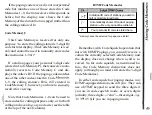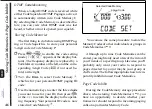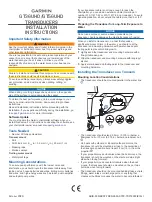
Recalling Memories
In confirming the results of the last example,
we used
to change from the VFO mode to
the memories after they were stored. The chan-
nel number appears at the display bottom when-
ever operating on a memory.
After at least one memory has been stored,
you can
for operation using the
DIAL,
or by direct keypad access.
If
you use the arrow keys, press and release the key
for each memory: if you hold the key down for
memory scanning will start. In any
case, only pre-stored memories are displayed:
empty memories are skipped. For direct keypad
access, simply enter the number of
channel you want, followed by the
key.
to
channel 5, simply
Note: Memories
L2
U2 can be accessed
in a similar fashion,
without
entering the
preceding the channel number:
To exit the
and return to the last-
used VFO, press
Call
Channel Memory
The Call channel memory for each band can
be instantly recalled by the
button.
appears below the frequency display for the re-
spective band. The Call channel memory is set to
bottom edge
of the band, but you can reprogram
it with any frequency and repeater state, or even
a separate transmit frequency.
To store the current VFO data in the Call
channel memory, hold
for
then
press
(CALL).
To store a separate transmit fre-
quency in the Call channel, after storing the re-
ceive frequency, tune the VFO to the transmit
frequency and repeat the above, but
time
holding
the
PTT
switch
while
you press
(CALL).
DTMF
Storing Independent Transmit Frequencies
All memories can store an independent trans-
mit frequency, for operation on repeaters with
non-standard shift. To do this:
Store the receive frequency using the method
already described under
Memory Storage
(it
doesn't matter if a repeater offset is active).
Tune to the desired transmit frequency, then
press and hold
for
to display
the memory label again.
Содержание FT-51R
Страница 1: ...FT 51R Dual Band FM Paging Transceiver...
Страница 43: ......
















































